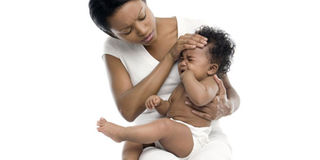Poverty and climate play a big role in poor results in Nyanza and Western

Children born in Central Kenya are more likely to celebrate their fifth birthday than those born in Nyanza or Western, thanks to better healthcare coverage and a more favourable climate. PHOTO | FILE| NATION MEDIA GROUP
What you need to know:
According to the Demographic Survey 2014 released last month, Kenya has made remarkable strides in the war against infant mortality in the last two decades.
However, discrepancies in the regional figures clearly indicate that a lot more needs to be done.
At Bondo District Hospital in Siaya County, Susan Amondi is rocking the older of her two children, one-and-a half year-old Onyango while his five-month-old brother, chuckles as he clings to her.
The nurse in charge tells DN2 that Onyango is suffering from malnutrition — and a host of other infections — and that their mother had to come with both of them when he was admitted because there was no one to look after the younger child.
Meanwhile, miles away at the Kiambu District Hospital in Kiambu County, eight-month-old Mary is also admitted and being looked after by her mother. She is suffering from a blood infection (sepsis).
A brief chat with the two women clearly indicates that they do not understand the ailments afflicting their children. And they are equally unaware of the bleak — or bright — future their geographical locations mean for their children’s survival.
While Susan is optimistic that her son will survive the sickness that has kept them in this hospital for more than three weeks, recent statistics show little Mary in Kiambu is more likely to live to see her fifth birthday than Onyango.
According to the Demographic Survey 2014, which was launched this year, certain regions in the country ensure better child survival than others, going by the diseases that claim children’s lives, as well as the medical seeking behaviour by parents of guardians, which also determine the survival of children.
Nyanza, Nairobi and Western are the least favourable regions for a child to grow up in while Central and North-Eastern are the best.
For instance, for every 1,000 live births in Nyanza, 82 will die, compared with only 42 in Central.
Nairobi comes second, with 72 deaths out of every 1,000 live births, followed by Western with 64 per cent.
These data mars the country’s otherwise good record.
According to a United Nations Children’s Fund (Unicef) report in 2014, Kenya had managed to significantly reduce mortality in children below the age of five.
For instance, in 2003, there were 115 deaths per 1,000 live births, but this number had been reduced to 52 by 2014.
The report attributed this reduction to improved medical care seeking behaviour, as well as using maternal healthcare services and delivering in proper health facilities.
It is worth noting that the deliveries in public health hospitals almost trebled after the President Uhuru Kenyatta announced in June 2013 that maternity services would be free at these facilities.
Knowledge and proper medical seeking behaviour of mothers on infectious diseases such as pneumonia and diarrhoea also contributed positively to the reduction in child mortality.
Yet the latest demographic survey highlights regional discrepancies that stand in stark contrast the impressive general indicators.
Nyanza and Western scored poorest in managing the diseases that claim children’s lives, namely malaria, acute respiratory infections and diarrhoeal diseases.
Severe diarrhoea, which causes dehydration, has been implicated in many studies by the World Health Organisation (WHO) as a major cause of sickness and mortality among young children.
Figures from Migori County indicated that 27.9 per cent of children in the area — the highest in the country — had suffered from diarrhoea.
This statistic is alarming as it is not only high, but also a pointer that the number of children who had stool with traces of blood, an indicator of the life-threatening strains of bacterial diarrhoea, were high.
Vihiga County recorded the second highest number of children who had suffered from diarrhoea with 23.6 per cent, followed closely by Homa Bay with 23.5 per cent.
Mandera, County recorded the fewest cases of diarrhoea, with 5 per cent, while Nyamira and Nyeri recorded 3 per cent each.
The Homa Bay County Executive for Health, Dr Lawrence Oteny, told DN2 that cases of water-borne diseases have remained “stubbornly” high because the latrine and toilet coverage in the area was still low, with seven for every 10 homes.
He added that poverty was a contributing factor to the poor toilet coverage.
“The soil in these areas is not stable, therefore digging latrines in homesteads is a challenge when the families are poor and cannot afford to pay for the construction,” he said.
Indeed, the demographic survey reported that: “Diarrhoea is less common among children who used improved, private toilet facilities (11 per cent) than among those who use non-improved or shared improved facilities (16 per cent)”
FEVER
Another childhood disease listed was fever, which is a sign of either malaria or other life-threatening infections.
The survey reported that Nyanza recorded the highest cases of fever in children, with 37 per cent, closely followed by Western with 36 per cent.
Pneumonia, an acute respiratory infection (ARI), and one of whose symptoms is also fever, remains the country’s leading killer of children under five.
Nyanza and Western reported the highest cases of children who had suffered from ARIs, standing at 9.7 per cent and 12.8 per cent respectively.
The counties with the highest percentages of children with symptoms of ARI were Vihiga (17 per cent), Bungoma (16 per cent), Baringo (14 per cent) Homa Bay and Migori (13 per cent).
Mandera recorded the lowest levels of ARIs with 2 per cent while Turkana, Garissa, Kisumu, Kirinyaga, and Nyamira, registered three 3 per cent each.
Notably, the counties with the highest cases of ARIs used firewood and charcoal as a primary source of energy for domestic use. Interestingly, studies have implicated the use of firewood in the relationship between indoor pollution and respiratory illnesses.
Vaccination
Remarkably, despite the discouraging statistics from Nyanza and Western the two regions performed quite well in public health interventions such as vaccinations.
According to WHO guidelines, a child is considered to have received all the basic vaccinations after being inoculated against the following diseases: tuberculosis, which is also known as BCG; three doses each of the DPT-HepB-Hib, which prevents diphtheria; whooping cough (pertussis); tetanus, also referred to as pentavalent; polio; and measles.
The vaccination coverage in Nyanza stood at 77 per cent while in Western, it was 81.
North Eastern performed the worst in this regard, with 55 per cent of the children there having been vaccinated.
Central maintained the lead, with 90.3 per cent of the children having access to all the vaccines. In fact, 97 per cent of the children in Kiambu County had received all the necessary vaccinations.
Of all the counties that make up Nyanza— Migori, Homa Bay, Siaya, Kisumu, Kisii and Nyamira— Homa Bay and Migori County had the worst indicators in the region, scoring the lowest on vaccination coverage, but the highest in Diarrhoeal diseases, ARIs and fever.
WHY THE DIFFERENCES?
Several explanations, both expert and layman, have been advanced to explain why the different regions record such widely differing figures.
On that is often cited is climate.
While the public health departments in the regions doing poorly can be blamed in part for not containing pandemics, Nyanza and Western are also climatically disadvantaged.
WHO classifies the two regions — as well as the Coast— as “malaria endemic”. Their location in low altitude areas, which range from 0 to 1,300 metres above sea level, makes it easy for malaria to spread.
Malaria, a disease caused by the plasmodium parasite that cannot thrive in the cold, high-altitude climate in Central Kenya, contributes greatly to the fatalities among children in Western and Nyanza.
The rainfall, temperature, and humidity in Nyanza shortens the life cycle of the plasmodium vector and increases its chances of survival for throughout the year.
Then there is a complicated issue involving the prevalence of HIV, a woman’s level of education and poverty.
Nyanza and the Coast have always recorded very high rates of teenage pregnancies, a factor that has kept many girls out of school.
Teachers in the affected areas like Kilifi, Homa Bay and Malindi cited poverty as a cause for these pregnancies.
Between 2012 and 2013, 17 girls dropped out of Nyajanja Secondary School in Kochia, Homa Bay County, alarming Mr Samuel Odhiambo Okelo, the principal, who had worked there for barely two years.
Most of these girls lack even the bare essentials like food and sanitary towels at home and when they can get them through men, the results are pregnancies,” he said.
According to the survey, 19.2 per cent of girls aged between 15 and 19 in Homa Bay County have already had a live birth, while 22.2 per cent within this age group are already married and, therefore, expected to have children.
In addition, contraception uptake among women aged 15 to 49 in the county is below average, standing at 46.7 per cent.
While youngsters between the ages of 15 and 19 in this region are sexually active, their use of contraception, even as disease preventing measures such as condom use, is the lowest, standing at below 5 per cent.
With a high incidence of pregnancies among young girls, enrolment in school is very low in the affected areas.
It is, therefore, hardly surprising that the report indicated that only 30 per cent of young mothers (under the age of 18) sought medical attention before, during and after delivery.
Nyamira County defies Nyanza trend
It is notable that Nyamira County’s health indicators stood in start contrast to the general trend in Nyanza.
Nyamira had the fewest cases of diarrhoea and ARIs, with only 3 per cent, the highest vaccination coverage (95 per cent), and a very low fever presence in children (5.7 per cent).
The county’s chief medical officer, in the Department of Health services, Mr Douglas Bosire, said that the county had spent the largest portion of its health budget on preventive and promotive medicine (Sh 150million), than on curative medicine, planning and administrative issues.
Mr Bosire attributed the commendable medical seeking behaviour of the people in the county to the strong community health network.
“They have taught people about toilets, using water properly, handling food and other issues about sanitation,” he explained.
***
FYI
According to World Health Organisation guidelines, a child is considered to have received all the basic vaccinations after being inoculated against the following diseases: tuberculosis, which is also known as
BCG; three doses each of the DPT-HepB-Hib, which prevents diphtheria; whooping cough (pertussis); tetanus, also referred to as pentavalent; polio; and measles.
Severe diarrhoea, which causes dehydration, has been implicated in many WHO studies as a major cause of sickness and mortality among young children.
The counties with the highest cases of ARIs used firewood and charcoal as a primary source of energy for domestic use. Interestingly, studies have implicated firewood as a probable cause of indoor
pollution, leading to respiratory illnesses.





